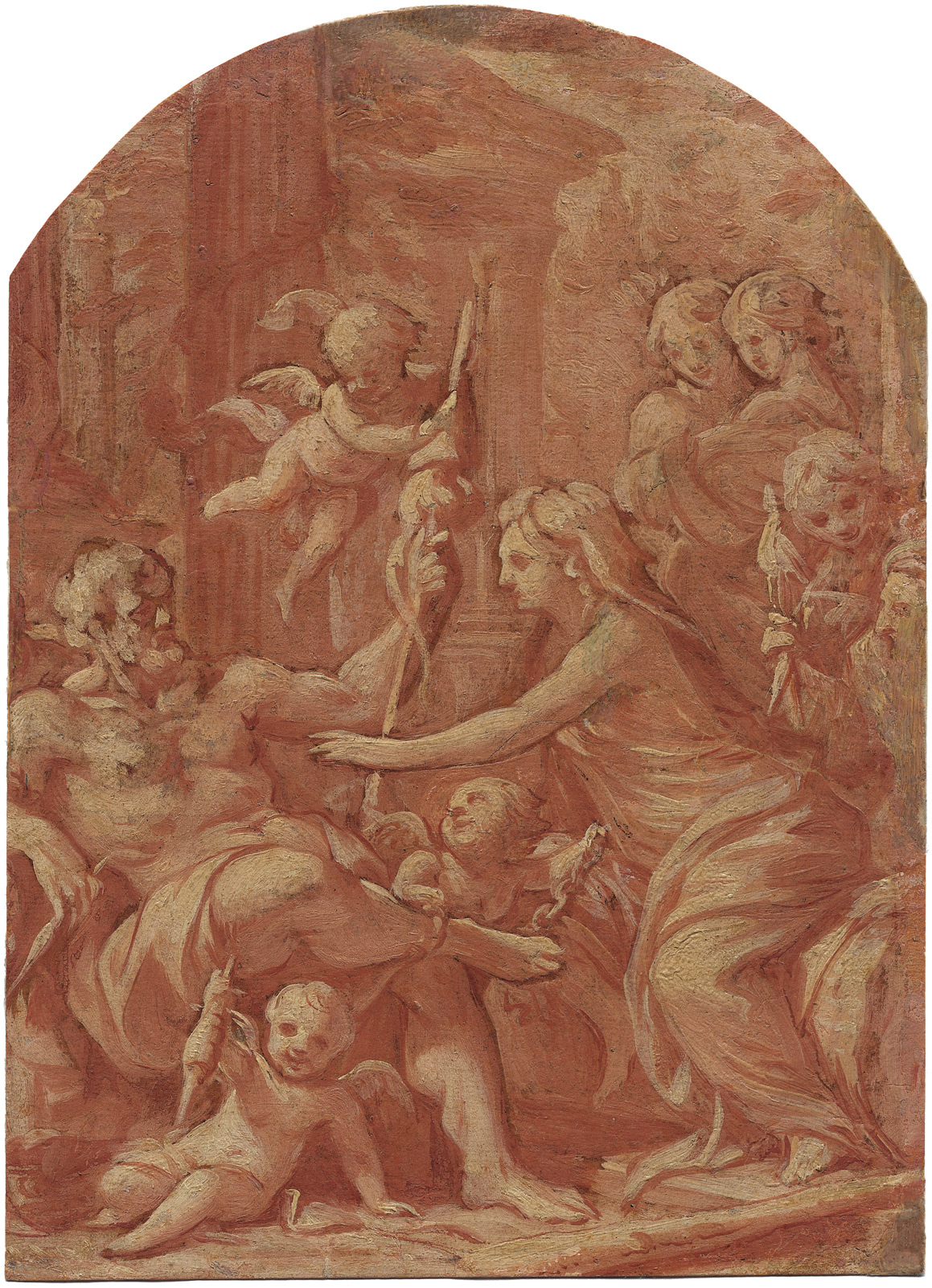Loading the page ...
Antonio Franchi
(called Lucchese, 1638 Villa Basilica/Lucca – 1709 Florence)
Hercules and Omphale. Oil on paper, mounted on thin cardboard. 21.3 x 15.3 cm.
The amusingly perverse tale of Hercules and Omphale has been a favourite motif in Western art since the 16th century. Having murdered Iphitus, Hercules was commanded by the Delphic Oracle to do penance by serving as a slave for a year. He was sold to Omphale, the Queen of Lydia, who made him do women’s work while she wore his lion skin and carried his club. When the Queen learned the identity of her prisoner, she married Hercules. Blinded by his love for Omphale, the hero let himself be reduced to wearing women’s clothing and spinning wool. When the days of his bondage were over, however, Hercules saw the error of his ways and left Omphale. The story was considered a scornful comment on male effeminacy.
This delightful bozzetto shows Hercules seated on a throne in self-confident pose, holding in his right hand a spindle instead of a sceptre. Omphale is leaning over to him with a loving gesture. A small cupid serves as a combining element. In both hands he holds a chain, which is meant to be a symbol of bondage and, in a figurative sense, as a symbol of the fetters of love. In the right foreground Hercules’ club lies neglected on the ground, testifying to the hero’s indolence.
The present oil sketch is a rare work by the Lucca painter Antonio Franchi. Franchi led an eventful life spent in various Italian art centres. In his home town Franchi was first a pupil of Giovanni Domenico Ferrucci and then of Matteo Boselli. While still a student in Lucca he attended the Accademia del Nudo founded by Pietro Paolini in 1640. By 1655 he was in Florence, where Baldessare Franceschini, known as il Volterrano, was one of his tutors. It was here that the young artist made his first attempts as a portrait painter. In the following period Franchi was alternately in Florence and Lucca. In the latter town he served as cleric and painter to Cardinal Girolamo Buonvisi in the years 1658–59 and devoted himself to the study of philosophy. Circa 1665–67 we find the artist in Rome, where he moved in the artistic circles around Pietro Testa and Antonio Gherardi. Sponsored by Volterrano and enjoying the patronage of such Florentine noble families as the Medici, Strozzi and Capponi, Franchi decided in 1674 to move for good to Florence, where he successfully established himself as a portraitist and painter of historical and mythological subjects, which he executed in the light, gracious style of the Late Baroque. Franchi was also a very versatile and well-educated man who wrote on matters of religion, philosophy, the natural sciences and art theory.
The artist’s drawn oeuvre is extremely rare. Only occasional works have been confirmed as being by him: two drawings in the Louvre (see C. Monbeig Goguel, Dessins Toscans XVIe – XVIIIe Siècles, Tome II 1620–1800, Musée du Louvre, Paris 2005, p. 252, nos. 328–329) and two more in the Musée des Beaux-Arts in Lille (see the exhibition catalogue Bellezze di Firenze. Disegni fiorentini del Seicento e del Settecento dal Museo di Belle Arti di Lille, by M. Chiarini, Palazzo Pitti, Florence 1991, pp. 88–91, nos. 39–40). Other attested works include two drawings in the collection of New York’s Metropolitan Museum of Art (see J. Bean, W. Griswold, 18th Century Italian Drawings in the Metropolitan Museum of Art, New York 1990, pp. 67–69, nos. 48–49). In addition, there is another autograph drawing in a private collection in Rome. All these works show the same sketchy character and are uniformly executed in a fluid Camaïeu technique in tempera or oils, with a preference for pinkish-brown shades and bright, yellowish-white heightening. The present composition thus represents a significant extension of the oeuvre. The format of this sketch is almost identical to that of the two drawings in Lille and shows strong stylistic analogies to these late works. The study Noli me tangere in particular shows a comparable compositional structure and striking correspondences in the use of light and spatial staffage. The round temple in the background is almost identical with the building shown here and the little angel hovering at the top of the picture reappears in this sketch in almost unaltered form. The main actors in the foreground are treated with fluent accuracy, and certain typological details in the figure drawing, such as the fleetingly indicated, claw-like hands and the summary treatment of the faces with the dark round eye sockets, are characteristic of Franchi’s formal idiom. Although somewhat stereotypical in execution, these sketches possess a lightness and panache that is characteristic of Florentine painting of the late Seicento.
Contact us for further information